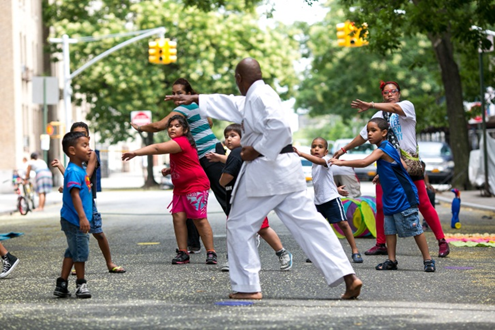
Visualizing Active Design
April 21, 2016
Active Design is NOT something you will find at a fashion designer’s latest runway show.
You may be surprised to hear that examples of Active Design are around us every day and in a wide variety of ways; from the buildings we inhabit, to the streets we drive on, and to the parks we play at. By implementing Active Design strategies, we are able to create healthier streets, urban spaces, and buildings, and therefore healthier communities. The following national examples have successfully incorporated Active Design into their buildings and urban design to make physical activity part of our daily routines.
New York City, NY
Built on an abandoned elevated railway, the High Line is a linear park carved out of New York City’s existing urban fabric that features a mixture of landscaping elements, including plantings, viewing decks, innovative “peel-up” benches, water fountains, and recreational pathways.
Active Design Highlights:
- Attractive linear paths with shifting landscaping elements and structural points of interest that inspire walking.
- Amenities that support extended visits to the park, including benches, water fountains, food vendors, shaded areas, and restrooms.
- Inviting staircases that encourage stair use.
New York City, NY
Placing motivational signs at points of decision – such as at the base of stairways or at elevator banks – can successfully prompt people to use the stairs. Because of strong evidence provided by research, the CDC Community Preventive Services Task Force recommends using point-of-decision prompts to increase the amount of people choosing to take the stairs rather than an elevator or escalator.
Active Design Highlights:
- Regular stair use has been linked with numerous health benefits, including reduced stroke risk, greater lower limb strength, reduced cholesterol levels, and improved cardiovascular health.
- Stair use helps burn calories and assists in weight management. Just two minutes of stair climbing per day can burn enough calories to prevent the average annual weight gain of U.S. adults.
- Stair use can also contribute to a reduction in building energy consumption by user not taking elevators or escalators.
Chicago’s Pedestrian & Cycling Plans
Chicago, IL
The City of Chicago has prioritized the creation of more walkable and bikeable streets through the implementation of the Chicago Pedestrian Plan and the Chicago Streets for Cycling Plan.
Active Design Highlights:
- Installed over 100 miles of protected bikeways and 10 miles of neighborhood greenways.
- Launched “Divvy,” a bike share system with 300 bike stations and 3,000 bikes.
- Installed an all-way pedestrian crossing, or “Barnes Dance” at the busy intersection of State Street and Jackson Boulevard.
- Launched several programs aimed at promoting pedestrian safety, including one that allows people to report unsafe driver behavior.
- Launched a Play Streets program in collaboration with a Partnership for a Healthier America.
New York City, NY
Play Streets offer a low-cost way for neighborhoods and schools to create more space for active recreation by identifying streets that can be closed to traffic for certain periods of time, in order to create new outdoor play spaces.
Active Design Highlights:
- Streets are converted to temporary recreation spaces for children and families.
- Programming organized by local organizations builds a sense of community and encourages more vigorous physical activity.
King County, Washington
The Greenbridge Master Plan includes Active Design strategies in site planning for affordable housing redesign mixed with recreational facilities.
Active Design Highlights:
- New and improved pedestrian paths establish a variety of routes, allowing residents to walk within their neighborhood and to nearby retail centers.
- Open spaces ranging in size were placed across the site and made accessible to people of all ages: community parks, food gardens, and pocket parks are connected by sidewalks, trails, and paths.
- Recreation spaces were located to create strong relationships with adjacent uses, such as homes, schools, and community centers, increasing safety and accessibility.




